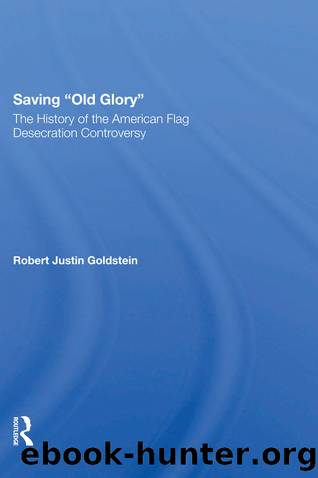Saving Old Glory by Robert Justin Goldstein

Author:Robert Justin Goldstein [Goldstein, Robert Justin]
Language: eng
Format: epub
Tags: History, General, United States
ISBN: 9780813323251
Google: QoNmAAAAMAAJ
Publisher: Avalon Publishing
Published: 1995-01-15T03:01:47+00:00
4
Flag Desecration Laws in the Courts During the Vietnam War Era
THE 1968 federal flag desecration law did not end incidents of flag desecration: In fact, the 1968-1974 period saw an explosion of flag desecration prosecutions unprecedented in American history, of which all but a handful were brought under state laws rather than under the new federal measure. As a result of the same climate that led to passage of the new federal law, about ten states revised their own flag desecration laws between 1967 and 1969 by drastically increasing existing penalties. For example, in addition to the 1967 Indiana revision previously discussed, Alabama, Oklahoma, and Illinois, each having previously penalized flag desecration with up to 30 days in jail and a $100 fine, increased their maximum punishments to between two and five years in jail and $3,000 to $10,000 fines. At least one city, Kent, Ohio, passed its own flag desecration law, in 1970, providing a penalty up to one year in jail and a $1,000 fine, after a student burned a flag on May 4, 1970, the day that four Kent State University students were shot to death by Ohio National Guardsmen during an antiwar protest.1
Although many states increased their penalties for flag desecration in the late 1960s, the basic elements of the overwhelming majority of the state laws were essentially intact from the original enactments of the 1900-20 period: In general, they outlawed placing any marks or pictures of the flag, forbade any flag usage for commercial purposes, and banned any physical destruction of flags or any "act or words" that publicly cast "contempt" on the flag (as previously discussed, the "words" provision of state laws was effectively struck out by the Supreme Court's 1969 Street decision). Almost all of the states also retained extremely expansive definitions of what constituted a "flag," as in the law in effect in New York in 1966, which included, in addition to flags per se, pictures and representations of flags of "any size" and of "any "substance," as well as any representations that included the flag's "colors, the stars and stripes, in any number thereto" such that a person seeing the object "without deliberation may believe the same to represent the flag." (Compare the 1968 federal statute in Appendix, Document 2.)2
Because most nag desecration prosecutions were "unreported" (local trial court proceedings that are not appealed as well as many that are generally not published or "reported" in standard legal references), it is impossible to uncover exactly how many such cases were tried or what percentage of them were successfully prosecuted. However, the Christian Science Monitor's unsourced 1973 estimate that "some 1,000" flag desecration cases had been prosecuted during the Vietnam War period is almost certainly an underestimate, as New York City ACLU attorney Burt Neuborne told a reporter in 1972 that he had personally handled over 300 such cases. Contemporary accounts differed wildly as to the general outcome of these prosecutions. For example, the ACLU reported in September 1970 that it was
Download
This site does not store any files on its server. We only index and link to content provided by other sites. Please contact the content providers to delete copyright contents if any and email us, we'll remove relevant links or contents immediately.
Twilight of the Idols With the Antichrist and Ecce Homo by Friedrich Nietzsche(18267)
CHERUB: The Recruit by Robert Muchamore(2125)
CHERUB: The Fall by Robert Muchamore(1963)
I Capture the Castle by Dodie Smith(1871)
CHERUB: Man vs Beast by Robert Muchamore(1868)
The Edge of the Abyss (Sequel to The Abyss Surrounds Us)(1696)
Black Genesis by Robert Bauval(1513)
all by Unknown Author(1477)
A Brief History of Everyone Who Ever Lived by Adam Rutherford(1449)
Where Do I Start? by Chase Taylor Hackett(1218)
2016 Baby Names Almanac(1152)
Spook Street (Slough House) by Mick Herron(1152)
Painfully Rich by John Pearson(1113)
How to Argue With a Racist by Adam Rutherford(1106)
Genetics by Adam Rutherford(1098)
Black Hawk Down by Mark Bowden(1019)
2011 Baby Names Almanac(1017)
Life After Life: A Novel by Kate Atkinson(999)
It's All Relative by A. J. Jacobs(990)
